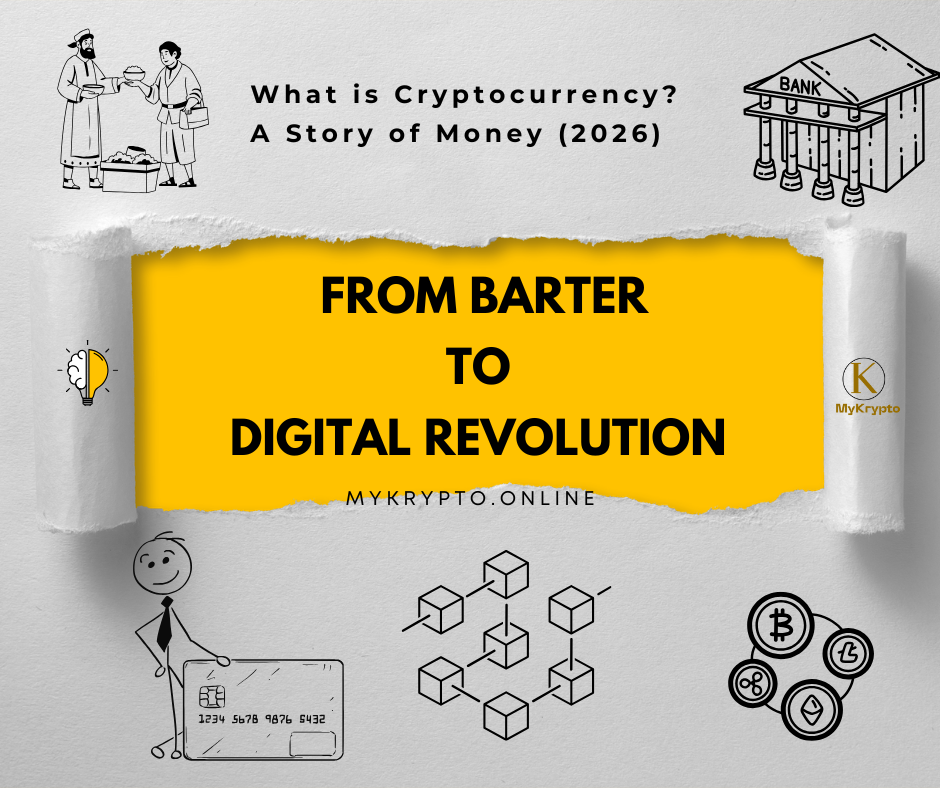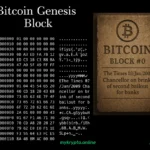Introduction | What is Cryptocurrency? | The Trust Machine: A Story of Money
Welcome to MyKrypto!
Hope you are good. Well, in today’s topic, I want to explore a story of money through the lens of human innovation and its flaws, leading to the digital revolution.
Chapter 1: The Farmer and The Blacksmith
Imagine a time when the world was smaller. A farmer, his hands caked with soil, walks to the next village with a sack of wheat. He meets a blacksmith, the air around him thick with the heat of the forge. The farmer needs a new plough. The blacksmith needs to feed his family. 

This was the barter system. A direct, visceral exchange of value. “I will give you this sack of wheat for that plough.” But what if the blacksmith didn’t need wheat? What if he needed cloth? The farmer would have to find a weaver who wanted wheat, trade for cloth, and then go back to the blacksmith. It was clunky, inefficient, and limited by the “coincidence of wants.” Value was tangible, but trade was a struggle.
Chapter 2: The Gleam of Gold
Human ingenuity found a way. We discovered something rare, beautiful, and durable: gold and silver. Suddenly, our farmer could sell his wheat to anyone for a few gold coins. He could then take those coins to the blacksmith, who accepted them gladly, knowing he could use them to buy anything, anywhere, from anyone.
Money was born. It was a universal token of value. It was portable, divisible (you could have a gold coin or a tiny sliver), and it held its worth over time. But this new system had a dark sibling: theft. A lifetime of savings, now condensed into a small chest, was a tempting target for thieves and marauders. The very portability that made it useful also made it vulnerable. Wealth required strongboxes, guards, and constant vigilance.
Chapter 3: The Promise in Your Pocket
To solve this, we built institutions. We took our gold to a trusted bank and received a paper receipt in return. This receipt was a promise: “The bearer of this note is entitled to X amount of gold upon demand.” People began trading these paper receipts instead of the heavy gold itself. It was convenient and secure.
Over time, governments took over this process. This paper promise became fiat currency—the Rupee, the Dollar, the Pound. It had no intrinsic value; you couldn’t eat it or use it to make tools. Its value was derived entirely from trust—the trust that your government would honor its promise and that others would accept it.
For a long time, this promise was backed by a glimmering guarantee. The Gold Standard. One Indian Rupee wasn’t just a piece of paper; it was a claim on a specific amount of gold. A country could only print currency if it had the gold reserves to back it. This discipline kept the system honest.

Chapter 4: The Broken Promise
But governments, like people, face temptations. Wars, economic crises, and the desire for growth created a powerful lure: print more money. So, one by one, nations abandoned the Gold Standard. The paper note in your wallet was no longer a claim on a physical asset. It was now a promise backed only by the word of the state and its economic power.
The central bank became the sole manager of this system. They could print money at will, a process now called Quantitative Easing. While sometimes necessary, this power had a dark side: inflation. When too much money chases too few goods, the value of each unit of currency falls. The savings your grandparents painstakingly set aside could slowly erode, their purchasing power melting away like ice in the sun.
Worse, this centralized control was prone to corruption and exclusion. The traditional banking system shut out billions. To have a bank account, you needed an identity, an address, and trust from the institution. The system was opaque; you had to trust that banks were managing your money responsibly, even after crises proved otherwise. The middlemen were back, and they were more powerful than ever.
Chapter 5: The Digital Uprising
In 2008, in the smoldering aftermath of a global financial crisis caused by this very trust in centralized institutions, an anonymous figure named Satoshi Nakamoto released a white paper. It was a blueprint for a new kind of money, born not in a mint, but in code.
This was Cryptocurrency.
Its answer to theft was cryptography—an advanced, unbreakable code that secured every transaction.
Its answer to centralized control was decentralization—a ledger (the blockchain) not held by one bank, but copied and maintained by thousands of computers worldwide.
Its answer to corruption and arbitrary printing was transparency and scarcity. Every transaction was visible on a public ledger, and for coins like Bitcoin, there was a strict, mathematical limit on how many would ever exist—no government could print more.
It was a return to the principles of gold—scarcity and durability—but in a digital, perfectly portable form. It was a system that didn’t ask you to trust a fallible institution, but to trust math, code, and a network that no single entity controlled.
Epilogue: The Cycle of Trust
The story of money is a story of our quest for trust. We moved from trusting in the immediate value of a good (barter), to trusting in a physical substance (gold), to trusting in a central authority (fiat currency).
Cryptocurrency is the next radical step in this evolution: trust in a decentralized, verifiable, mathematical system.
It is not a perfect conclusion. Its price is volatile, its technology can be complex, and it faces its own forms of crime and regulatory challenges. But at its heart, it represents a fundamental shift—an attempt to build a global, open, and permissionless financial system for the digital age, learning from the flaws of every system that came before it. The journey from the farmer’s wheat to the digital token in a crypto wallet is a long one, but the goal remains the same: to find a better way to exchange value, securely and freely.




